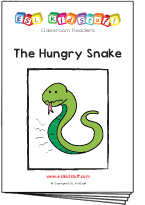Vegetables lesson plan
Stand-alone lesson ESL kids lesson plan
Lesson plans for ESL kids teachers
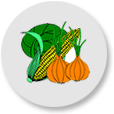
Vegetables
In this lesson students practice talking about different types of vegetables. Students sing a song, make a vegetable basket craft and practice saying their likes and dislikes.
Members get accompanying flashcards, worksheets, song and classroom reader.
Download materials:
Our lesson plans are FREE!
Sign up for accompanying:
✔ worksheets
✔ homework sheets
✔ craft sheets
✔ flashcards
✔ song downloads & videos
✔ classroom readers & videos
Click to see lesson details, materials and supplies
Age: 3-7 years
Time: 40 mins – 1 hour
Objectives: Talking about different vegetables, saying likes and dislikes.
Structures: “I like~”, “I don’t like~”
Target vocabulary: farmer, farm, growing, carrots, potatoes, cabbages, onions, pumpkins, corn, radish, lettuce, basket, yummy, delicious.
Lesson materials
Flashcards:
- carrot, potato, cabbage, onion, pumpkin, corn, radish, lettuce
Printables:
- Vegetable basket craft – sheet A
- Vegetable basket craft – sheet B
- Vegetable basket worksheet
- Reader worksheet
- Mr. Farmer’s vegetables song poster
Songs:
- Mr. Farmer’s vegetables
Readers:
- The farmer’s vegetables
Additional materials:
- Vegetables vocab crossword
- Vegetables vocab wordsearch
- Vegetable shopping worksheet
Supplies:
- [hide_on_uk]colored[/hide_on_uk][hide_on_us]coloured[/hide_on_us] crayons / pencils
- real vegetables OR plastic vegetables OR flashcards / pictures for the following: carrot, potato, cabbage, onion, pumpkin, corn (on the cob if possible), radish, lettuce
- paper / plastic bowls (1 per student)
- plastic spoons (1 per student)
- 1 large cooking pot and a ladle
- 1 blindfold
- construction paper / card (to glue the basket craft on)
- glue
- Blu-Tack or tape to stick flashcards on the wall
- cushions (1 per student)
- device to play the song on
This is a fun lesson which introduces some common vegetables. Students will sing a song, make a vegetable basket craft and practice saying their likes and dislikes.
Lesson procedure:
Warm up and maintenance:
The beginning of your lesson is extremely important: this is where you set the tone of your lesson and get everyone in the right frame of mind for learning English. It is also an opportunity to check homework and review previous lessons.
Click for warm up suggestions for the start of your lessons
These activities can be done in the following order at the start of your lesson:
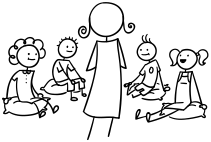
1. Welcoming
Greet the students by name as they enter the classroom and gesture for them to sit down. If you have space on the floor, it’s a good idea to have a cushion for each student as this makes sitting arrangements easy to [hide_on_uk]organize[/hide_on_uk][hide_on_us]organise[/hide_on_us]. Try and arrange the cushions beforehand spaced out in a fan-shape around you.

2. Name tags
Before class prepare some name tags (stickers or pin-on tags) with each student’s name written in lower case letters. Sit down with your students and lay out the name tags in front of you. Pick up each tag and call out the name. Try and encourage each student to put their hand up and say “yes”. Hand over the tags and help to pin / stick on. Later on as your students recognize their written names you can have each student in turn pick out their own name tag.

3. Greetings
Use a glove puppet (such as a Sesame Street puppet) to greet the students. Keep him in a cloth bag. Bring out the bag, open it enough to see in and shout into the bag the puppet’s name (e.g. “Cookie Monster!”). Then move your ear to the opening to listen – nothing. Go to each student and encourage them to shout the puppet’s name into the bag – each time nothing happens. Finally, get all the students together to shout the name at the same time. This time the puppet wakes up and jumps out of the bag! The puppet then chats to each student:
Puppet (teacher): Hello, What’s your name?
Student Hello. My name is….
Puppet: Goodbye / See you!
Student: Goodbye / See you!
As your students learn more phrases, you can include them in the conversation, such as “How old are you? Do you like …?, Can you …?, etc.
Finally, the puppet goes back into the bag and back to sleep.
4. Sing the “Hello song” or a review song
Sit in a circle and sing along to the song. Encourage students to clap along or pat their laps in time with the music. The Hello song is a good song to start the lesson with, especially as it has an accompanying Goodbye song to sing at the end of the lesson.
Lyrics for the “Hello song”
Hello, hello, Hello, hello,
How are you? How are you?
I’m fine, thank you, I’m fine, thank you,
We’re ok, We’re ok.
Lyrics for “The Hello Song”
Hello, hello,
How are you today?
Hello, hello,
How are you today?
I’m fine, thank you,
I’m fine, thank you,
I’m fine, thank you,
And how about you?
Hello, hello,
How are you today?
I’m fine, thank you,
And how about you?
Gestures for the “Hello song”
These are quite straight forward. First time you play the song do the gestures and encourage everyone to do them with you.
- Wave as you sing the “Hello, hello” parts.
- Gesture to others as you sing, “How are you today?”
- Point to yourself as you sing, “I’m fine, thank you”
- Hand gesture towards another student as you sing, “And how about you?”.

[hide_on_uk]Short sample (members get full-length song):
[/hide_on_uk]
[hide_on_us]Short sample (members get full-length song):
[/hide_on_us]
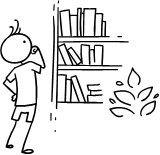
5. Read a classroom reader again
As you progress through the lessons you will start to build up a catalog of classroom readers. Kids love going back to old stories and reading through them again. Invite a student to pick a classroom reader and read through it as a class. Make the story as interactive as possible by asking questions (e.g. what [hide_on_uk]colors[/hide_on_uk][hide_on_us]colours[/hide_on_us] there are, the names of different objects, etc.) and getting students to speculate what is going to happen next in the story.

6. Homework check
Check each student’s homework set in the last lesson. Ask each student some questions about their homework worksheet (e.g. “what [hide_on_uk]color[/hide_on_uk][hide_on_us]colour[/hide_on_us] is it?”), give lots of praise, and then put some kind of mark on the homework sheet (e.g. a sticker, a stamp or draw a smiley face). Finally, tell your students to put their homework back into their bags.
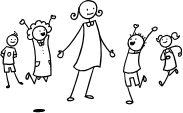
7. Do “Exercise routine” activity
Say the following and have your students follow your lead: “Stand up (teacher stands and so does everyone else), “Hands up / hands down” (x 3-5), “Jump” (x3-5), “Run! / Stop!” (x3-5), “Turn around! / Stop!” (x3-5), finally “Sit down”.
Throughout the course you can introduce other commands, such as “Hop”, “Star Jump”, “Wiggle”, “Crouch” and so on.
Extra activity: Once your students have got to know these exercises you can play “Teacher says” using these actions.
This is basically the game ‘Simon says’ but using the words “Teacher says” instead. The teacher tells the students to do an action and they do as asked (e.g. “Teacher says … jump 3 times”). The teacher keeps on giving instructions with different actions using “Teacher says …”. At some point the teacher gives a command without using the phrase “Teacher says” (e.g. “Hop 5 times”) and the students must not do that action – they have to stay still. Any students that do the action have to sit out for the rest of the game. The last student standing is the winner.
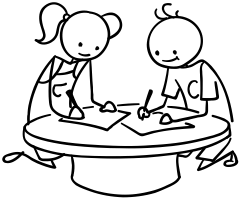
8. Name writing practice
If your students cannot write their names yet, this is a great activity. For really young ones, don’t worry if their effort is a scrawly mess – always encourage and praise.
You will need to prepare a writing sheet for each student before class with their name written in dots for them to practice tracing their names (also prepare one for yourself so you can model the task). You can either make these yourself (hand draw the dots for each name) or use a font typed into a Word document – we like to use the “National First Font Dotted” font (you can download it for free here: http://www.fontspace.com/roger-white/national-first-font-dotted).
Prepare the sheets something like this:

Make a few extra copies of each student’s name writing sheet so you can use them in future lesson or for homework.
When everyone has finished writing their names, get each student to hold up their sheet so you and everyone can see. Give lots of praise to each student.
9. Review past lessons
Reviewing past lessons is very important – students need constant practice of new vocab, structures, songs, games and so on. Always review parts of your last lesson as well as some parts from other previous lessons. You can spend 5-10 minutes reviewing – it’s fine to recycle games and activities from your past lessons to review as kids enjoy playing familiar games (although be careful not to play a game to death!).
Note: You can also include review activities in the main body of your lesson. Kids can have short attention spans so it’s good to be able to pull out lots of activities during different stages of the lesson.
Other ideas to include in your warm up:
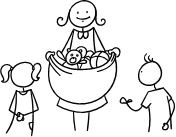
What’s in the bag?
This is a great activity to do at the beginning of your lessons. Fill a large cloth bag with items from your previous lessons (e.g. plastic fruit, animals, etc.). You can also throw in a few other objects (e.g. a pencil, a plastic bottle, a plastic cup – anything lying around (and safe!)). Show the bag to your students and shake it to rattle the objects inside. Pull out different objects, teach/elicit their names, have students hold and pass the objects around. You can even have students pull objects out of the bag. Pull out 1 or 2 objects per student. Finally, place the objects around the classroom and have each student retrieve each object as you call out its name and put it back in the bag.
Knock-knock
This can be used at the beginning of each class. Teach the students to knock on the door before entering the classroom. There are 2 variations for the next step:
- When the student knocks, teacher says, “Who’s there?”. The student replies, “It’s (Koji)” and then the teacher says, “Come in (Koji)”.
- When the student knocks the teacher must guess who it is, “Is that (Koji)?”. The student replies yes or no – if no, the teacher continues guessing. Having your students develop their own knocking styles makes this even more fun.

Spin the bottle
Sit students in a circle with a bottle in the middle. Teacher spins the bottle. When it stops spinning the student it is pointing at has to answer a question. If the answer is correct then that student can spin the bottle. For example, How are you? What’s your name? What is this? (show an object or flashcard) Do you like _?, etc.

Talk about the weather (do after you have taught the weather lesson plan).
- Prepare a weather board. Before the first class prepare a piece of cardboard and cover it with felt – you are going to pin this to the wall. If you can, try and get blue felt (to represent the sky). Write at the top in large letters, “How’s the weather today?”. Below the write “Today it’s”. Cut out weather pictures (such as our weather flashcards) and stick some velcro on the back. Arrange the weather pictures around the edge of the board and then put the board on the wall of your classroom. You can now use this weather board at the beginning of every lesson.
- Sing “The weather song”. Sing the song together doing all of the gestures.
- Look outside. Get everyone to look outside by saying, “How’s the weather? Look outside”. Elicit the weather for that day.
- Put the weather pictures on the weather board. Invite some students to come up and put the weather pictures on the board. Make sure these students say the word as they put the card on the board.
New learning and practice:
1. Play “Find the vegetables”
If possible, before class buy one of each of the following vegetables (and other kinds if you like): a carrot, a potato, a cabbage, an onion, a pumpkin, corn (on the cob if possible), a radish, a lettuce. If you can’t bring vegetables into class, other options are: plastic vegetables (sometimes available at dollar [hide_on_uk]stores[/hide_on_uk][hide_on_us]shops[/hide_on_us] and toy [hide_on_uk]stores[/hide_on_uk][hide_on_us]shops[/hide_on_us]), vegetable flashcards, vegetable photos cut out of free supermarket magazines. Also, bring in a basket for the vegetables.
Before your students enter your classroom hide the vegetables all around the room – in draws, behind books, under things, etc. Once you are ready to begin the main part of your lesson, have everyone sit down and say to your students, “Let’s look for some vegetables!”.
Then stand up and demonstrate that you are searching for something. Find one of the vegetables (e.g. under a cushion) and show your thrill in doing so. Take it over to the basket and drop it in saying, “Put it in the basket”. Then get everyone to hunt around the room until all of the vegetables have been found and placed in the basket.

2. Teach vegetable vocabulary
Hold up the first vegetable and chorus the word three times (e.g. “carrot, carrot, carrot”). Then pass the vegetable around the class, each student saying the name as they pass it. Do this for all of the vegetables.
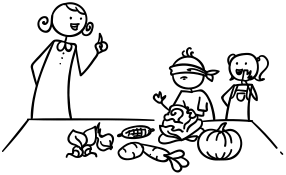
3. Play “The missing vegetable” and “Blindfold touch”
Line all the vegetables up on a desk. Say, “Close your eyes” and get everyone to cover and close their eyes. Take away one of the vegetables and hide it behind your back – everyone must open their eyes and shout out the missing vegetable. Play this until all of the vegetable vocabulary has been practiced.
Keep the vegetables lined up on the desk. Take out a blindfold and model the activity – put on the blindfold then touch and feel one of the vegetables. Look confused and say the wrong word (e.g. touch a cabbage and say, “Is it a carrot?”). Get the students to help you until you guess correctly. Then blindfold one student, turn him/her around 3 times and help him/her to go to the desk and touch/feel one vegetable and say what it is. Give all of the students a turn.
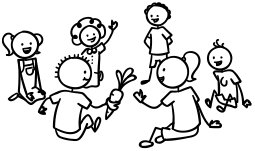
4. Play “Musical pass the vegetables”
Sit everyone in a circle, put on some music, and have everyone pass all of the vegetables around the circle (in the same direction). So the music will be playing and all of your vegetables will be going around the circle. Suddenly stop the music – the students holding the vegetables must shout out the name of the vegetable they are holding. The last person to shout out the correct word is out (and also remove their vegetable). Keep playing, with each round the last person going out. This should end with just 2 students passing two vegetables back and forth. It’s a really fun game!
5. Read classroom reader “The farmer’s vegetables”
Before class, download and print off the reader “The farmer’s vegetables”. As you go through each page, point to the pictures and elicit each key word, and also make sure everyone is aware if the rabbit hiding in each picture, for example:
Teacher: What is this?
Students: Corn!
Teacher: And what’s missing?
Students: Carrots!
Teacher: And who’s hiding here?
Students: A rabbit!
Get the students really involved in the story by asking lots of questions (e.g. eliciting [hide_on_uk]colors[/hide_on_uk][hide_on_us]colours[/hide_on_us], clothes and other objects) and try and get everyone to speculate why the vegetables keep disappearing.
After reading the story, give out a reader worksheet to each student and read through the story one more time (without stopping for questions, etc.) as students write the order that the rabbit eats the vegetables. Then go through the answers as a class.
Alternatively, watch our video version of the reader (Internet connection required).
6. Sing the “The farmer’s vegetables” song
Prepare for the song by taking out the flashcards of the vegetables. Show each one in the order of the song (so carrot first, potato next, etc.) and stick each one on the walls of the classroom. Try and get it so that the cards are evenly distributed around the walls (still in the order of the song) so you will have to turn 360 degrees to look at all of the cards. Alternatively, you can use the song poster.
Get everyone to stand up and dance, sing and point to the vegetables, as described in Gestures below. You can play the song 2 or three times.
Lyrics for “The farmer’s vegetables”
Chorus:
Oh, Mr. farmer, what are you growing?
On your farm, on your farm.
Oh, Mr. farmer, tell us what you’re growing,
On your farm, on your farm.
Verse 1:
I am growing carrots, carrots,
I am growing potatoes, potatoes,
I am growing cabbages, cabbages,
I am growing onions, onions.
Chorus:
Oh, Mr. farmer, what are you growing?
On your farm, on your farm.
Oh, Mr. farmer, tell us what you’re growing,
On your farm, on your farm.
Verse 2:
I am growing pumpkins, pumpkins,
I am growing corn, corn,
I am growing radish, radish,
I am growing lettuce, lettuce.
Gestures for “The farmer’s vegetables”
Before playing the song, put flashcards of the vegetables all around the walls of the classroom (in the same order of the song). Then start the song and do the following gestures:
- During the chorus have everyone do the cowboy dance – thumbs in belt hoops and kicking your legs out in time with the music.
- For the verses point to each of the vegetable flashcards on the wall.
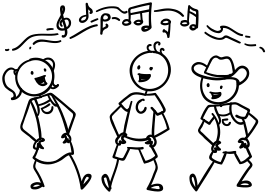
[hide_on_uk]Short sample (members get full-length song):
[/hide_on_uk]
[hide_on_us]Short sample (members get full-length song):
[/hide_on_us]
7. Do the “Vegetable basket craft”
Use the following craft sheets:
- Vegetable basket craft – sheet A
- Vegetable basket craft – sheet B
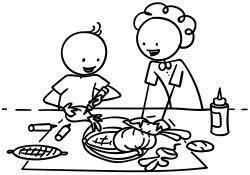
Before class, print off enough craft sheets for each student as well as yourself and cut out the basket and vegetable pictures. Give the cut-outs to each student and then get everyone to follow you as you [hide_on_uk]color[/hide_on_uk][hide_on_us]colour[/hide_on_us] in the vegetables and the basket – as you are doing this chat with your students, asking questions such as, “What [hide_on_uk]color[/hide_on_uk][hide_on_us]colour[/hide_on_us] shall we use for the potato?”, “Do you like cabbage?”, “What’s your [hide_on_uk]favorite[/hide_on_uk][hide_on_us]favourite[/hide_on_us] vegetable?”, etc.
When everything has been [hide_on_uk]colored[/hide_on_uk][hide_on_us]coloured[/hide_on_us] in, glue the baskets to construction paper and get the students to put in their vegetables (have them say the names of the vegetables as they do so).
An alternative is to print off just one large basket and get everyone to put their [hide_on_uk]colored[/hide_on_uk][hide_on_us]coloured[/hide_on_us] vegetables into the “class basket”.
8. Play “Let’s make vegetable soup”
To finish off the lesson we are going make some imaginary vegetable soup. You need a large cooking pot, ladle and some plastic/paper bowls and spoons.
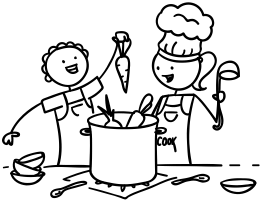
Say, “I’m hungry. Let’s make some soup!” (while rubbing your empty stomach). Take out the large pot and say, “Let’s cook vegetable soup! We need some vegetables”. Model by taking one of your vegetable cut-outs from your craft basket – say, “Yummy, I like (radish)” and put it into the pot and stir. Then say, “Hmm. We need some more vegetables”. Invite each student to take some of their vegetables from their craft basket and put into the pot, saying, “Yummy, I like ~”. Keep stirring – you can also invite students to give the soup a stir.
Finally, say, “The soup is ready!”. Get everyone to hold out their bowls and ladle in some imaginary soup. If some students refuse, this is fine – try and get them to say, “I don’t like vegetable soup”. Then say, “Let’s eat!”.
Make lots of slurping noises and say things like “Yummy!” and “Delicious!” and encourage everyone else to do the same. You can even offer seconds! Finish off by getting everyone to retrieve their vegetable cut-outs from the pot and put back into their baskets.
Wrap up:
Assign homework: “Vegetable basket” worksheet
Click for wrap up suggestions for the end of your lessons

1. Assign homework
Each week give out a homework worksheet for your students to take home. Hold up the homework worksheet and model how to do it. Give out the worksheets and say, “Put your homework in your bags” and help them to do so – this is important as they will probably want to start [hide_on_uk]coloring[/hide_on_uk][hide_on_us]colouring[/hide_on_us] them right away.
If possible, encourage the parents to help out as much as possible with their child’s homework – it is a great way to have your students practice the target language outside of class.

2. Say goodbye to glove puppet
Take out the bag again and get everyone to wake up the glove puppet by shouting its name into the bag (e.g. “Cookie Monster!”). Bring out the puppet and go through the same routine – go to each student and say hello, ask their name and the say goodbye / see you. Then put the puppet back in the bag (back to sleep).
3. Sing the “Goodbye song”
The “Goodbye song” is a great way to sign off the class. Sit together in a circle and sing and clap along. You can also use a different song, especially if your students love a particular song.
Lyrics for the “Goodbye song”

Goodbye, goodbye,
See you again.
Goodbye, goodbye,
See you again.
It’s time to go,
It’s time to go,
It’s time to go,
See you next time.
Goodbye, goodbye,
See you again.
It’s time to go,
See you next time.
Gestures for the “Goodbye song”
These are quite straight forward. First time you play the song do the gestures and encourage everyone to do them with you.
- Wave as you sing the “Goodbye, goodbye” parts.
- Hold your hand above your eyes (as you would when you are looking into the distance and keeping the sun out of your eyes) and look at another student as you sing, “See you again”.
- Tap watch (or imaginary watch) and then point to the door as you sing, “It’s time to go”.
- Point towards another student as you sing, “See you next time”.
[hide_on_uk]Short sample (members get full-length song):
[/hide_on_uk]
[hide_on_us]Short sample (members get full-length song):
[/hide_on_us]

4. Do “Quick check” and say goodbye
Time to leave the class. Make sure everything is put away and the students have gathered their belongings. Have them line up at the door and place yourself between the door and the students. For each student check one new word or phrase, for example:
- hold up an object or flashcard (such as a [hide_on_uk]color[/hide_on_uk][hide_on_us]colour[/hide_on_us] or fruit) and ask, “What’s this?”
- say an action for the student to do (e.g. “Roar like a lion”, “Jump 5 times”, etc.)
- ask a question from the lesson (e.g. “How old are you?”, “Do you like bananas?”, “Can you play chess?”, etc.).
- for very young students you can hold up one of the worksheets you did in the lesson and ask them to touch an object (e.g. “Touch the melon”).
When they give you the correct answer say goodbye and let them leave. If their answer is wrong, have them go back to the end of the line – they will have to try again once they reach the front!
Other lesson plans
Actions, verbs & tenses:
- Can – for ability
- Morning routines
- Daily routines & times of the day
- Actions – Present continuous
- Future plans using “going to”
- Past tense activities – Regular verbs
- Past tense activities – Irregular verbs: Part 1
- Past tense activities – Irregular verbs: Part 2
Adjectives:
- Describing people
- Describing things
- Comparing things (Comparative adjectives)
- Comparing things (Superlative adjectives)
Adverbs:
Alphabet:
Animals:
Body:
Classroom:
Clothes:
Colors:
Colours:
Directions:
Family:
Feelings & emotions:
Food:
Health & sickness:
Holidays & festivals:
Jobs:
Likes, dislikes & favorites:
Likes, dislikes & favourites:
- Likes & dislikes
- [hide_on_uk]Favorites[/hide_on_uk][hide_on_us]Favourites[/hide_on_us] and asking why
Nature & Our world:
Numbers:
Places & where we live:
Prepositions of location:
Pronouns:
Shapes:
Shopping:
Sports:
Time, days, months, seasons:
Toys:
Transport & travel:
Weather:




